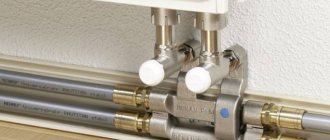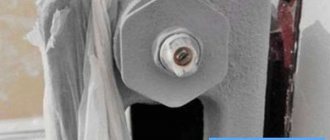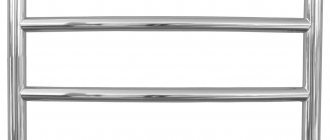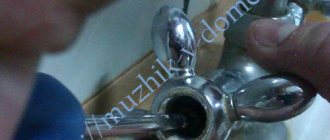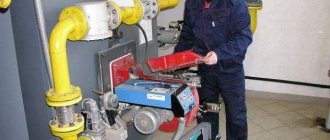Yesterday I already asked - in the large room the radiator is a little warm, the solution is to call the Gavriks from the housing office to vent the air. Breaks. Maybe try it yourself? I called the person who did all the plumbing in the apartment - he says it’s bullshit - war - you twist it with a screwdriver, you hear a hissing sound, when it drips, we close it. All. It seems that it’s not so difficult, although again yesterday they warned you - better not touch it - otherwise you’ll get to know your neighbors. So what will the collective mind say?
You just got it WRONG and WRONG! There is air - but not in your battery, i.e. all you get after playing with the Mayevsky tap is a full plate of cold water.
THE AIR MUST BE REMOVED FROM THE Riser!
And this is done IN the attic - there is a regular water tap - it opens and the air is released. The main ambush is what to do with the water that is flying out at the same time! In ancient houses, you put a hose on the tap and stick it out from the roof onto the street.
Re: > It breaks. Maybe try it yourself? I called the person who did all the plumbing in the apartment - he says it’s bullshit - war - you twist it with a screwdriver, you hear a hissing sound, when it drips, we close it.
They installed the battery for me, I immediately asked to show how to bleed it - everything was as they said below, and don’t forget where the “hole” points. A tea saucer or even a rag will suffice. How it flows in a steady stream means everything. Unscrew – half – 1 turn.
Those. There's a long thread - won't the screw come out right away? What’s scary, of course, is not the process itself, but the lack of understanding – i.e. If there is enough thread space to unscrew it a couple of turns, then it’s fine - it’s scary that after a couple of turns the screw might come loose, boiling water will pour out and you won’t be able to screw it back in. Wow! 
PS In general, honestly, I don’t understand what kind of air lock it is. There, the water CIRCULATES, which means the air plug moves through the pipe - how can it get stuck in the battery. Or why am I not an understand?
Air gets clogged into the furthest sections. It turns out that these sections fall out of the circulation circuit, the coolant passes only through the sections closest to the supply line.
Therefore, if the distant sections are noticeably colder than the nearby ones, there is definitely a traffic jam.
Bleeding air with Mayevsky's tap is not at all scary. Arm yourself with a more powerful screwdriver and carefully unscrew the screw, placing a container or plastic bag under the nozzle. The coolant is not pure water, so avoid getting it on the walls and floor so as not to stain the wallpaper, etc.
There are more than enough threads there; that’s why it’s called the Mayevsky CRANE. This is not just a hole with a screw.
that’s why it’s called the Mayevsky CRANE. This is not just a hole with a screw.
and corks because water and air have different densities (very different) and under the influence of gravity they separate. Water flows and circulates, but air, at the slightest opportunity, tends to float up and get stuck somewhere. 
Super! Thank you! How many revolutions, offhand? Is it better to unscrew? And also, is this plug stuck in my radiator or is it still circulating? My point is that by bleeding the air, I will solve the problem for the season, or maybe another traffic jam will arrive..
Thank you! How many revolutions, offhand? Is it better to unscrew? And also, is this plug stuck in my radiator or is it still circulating? My point is that by bleeding the air, I will solve the problem for the season, or maybe another traffic jam will arrive..
The taps are slightly different in design. Unscrew slowly until it hisses. As a rule, the traffic jam may appear again, but this time it will be smaller. After a week or two, try poisoning again.
Instead of a bag, for example, I use a dry rag.
People who hear about this device for the first time have a question about what a Mayevsky crane is and what it is used for. The device consists of a cone-shaped screw and the body itself, into which this screw must be screwed.
The Mayevsky crane is used to free radiators from excess air.
Very often, when heat is supplied to the general heating system, so-called air pockets can form, which cause a lot of inconvenience.
In this case, installing a Mayevsky crane is simply irreplaceable. One of the first signs by which one can determine whether the system is airy is the weak heating of the batteries at a high temperature of the general heating system. The main reasons are low hot water supply speed or small quantity.
Application
Construction of the Mayevsky crane.
The Mayevsky tap has several configurations, so depending on them, it can be opened either manually or with a special (sometimes open-end) key or even with an ordinary screwdriver. The thread of the tap is completely standard, so in order to open it if necessary to remove air, you only need to make half a turn counterclockwise. After the tap is opened, a characteristic hissing sound will be heard as air comes out. After the air, water will come, just at this moment the tap should be closed. This process is simple, so it can be carried out by a person without special skills.
This faucet is classified as a manual type device and is used based on expediency in central heating systems. If the system is closed or autonomous, then in such cases it is recommended to use an automatic Mayevsky valve, which eliminates air jams without mechanical intervention. Using such a device in closed systems is very convenient and does not require constant monitoring of the battery condition.
Ball valve design and types
Ball valves are usually used for installation on radiators. This is a relatively simple device that consists of the following elements:
- gate;
- rod with seal;
- sealing washer;
- sealing seats;
- housing and adjusting nuts;
- control handle;
- frame.
The shutter is a metal ball with a hole in the center. The handle allows you to move the shutter to one of two positions: “closed” or “open” - by turning it 90 degrees. Such a simple device ensures a reliable design and a relatively low price.
Most often, ball valves are made of durable brass or similar alloys; durable modern plastics and effective lubricants are also used in their production. Another advantage of the ball valve is its compact size. For a small device it is easier to choose a suitable place in the system.
The diagram shows in detail the design of a ball valve, which allows you to understand the operating principles of this simple and reliable design
Depending on the throughput there are:
- full bore;
- standard;
- partial bore ball valves.
The first pass 90-100% of the coolant flow, the second - about 70-80%, and the third - only 40-50%. For installation on a radiator, it is recommended to install full-bore structures that will ensure that there are no significant obstacles to the coolant, which has a beneficial effect on the efficiency of heating the room.
On sale you can find ball valves made of plastic, but they are not suitable for hot water supply or heating pipelines because they do not withstand high temperatures. Brass ball valves for radiators are also distinguished by installation method:
Coupling taps are usually recommended for use when installing heating systems; they are also suitable for water and gas pipelines. They are used both in residential premises and in the arrangement of public buildings. These are small devices, easy to use and very reliable. They are easy to install and usually do not require special, complex equipment. Such structures are mounted on pipes with a cross-section of no more than 40-45 mm.
When choosing valves for larger diameter pipelines, it is recommended to pay attention to flanged designs. They are designed for pipelines with a diameter of more than 50 mm. During installation, be sure to use special sealing gaskets to ensure sufficient strength and tightness of the connection between the tap and the pipeline. Flanged ball valves are strong enough to be used in heating systems.
There are collapsible flanged valves and non-separable ones. The first ones have a collapsible body, which will be very convenient when replacing worn or damaged parts. Most often, replacement requires a gasket, sometimes you have to install a new valve, etc. Non-separable flanged valves have a one-piece body. If it breaks, you have to completely replace the entire structure.
Installation of the device
You can bleed the air yourself, but if after this the battery does not become warmer, you need to call a specialist.
No special tools are required to install and use the faucet. The thread itself at the connection points is universal, so the device can be easily connected to a variety of heating systems.
Today's houses often have single-pipe heating systems, which are not convenient because the water circulation in them is impaired, which leads to frequent airing of the radiators. Such air pockets can completely stop the circulation of hot water in this system. This can lead to rusting of pipes and further unpleasant consequences.
The Mayevsky valve should be installed only in those areas of the system where air pockets most often occur. You can install it yourself, the main thing is to follow the following instructions: unscrew the valve on the side of the battery and screw the device into its place.
Video: screwing the Mayevsky tap into the heating radiator
Save time: selected articles delivered to your inbox every week
The coolant circulating in the heating radiators provides us with heat during the cold season. However, situations often arise in which the battery does not warm up completely. They arise due to the accumulation of air in the far part of the radiator, which prevents the radiator from filling with hot water. Therefore, it needs to be removed somehow. For this purpose, a Mayevsky valve is used, the operating principle of which is based on bleeding air pockets when the shut-off cone valve is loosened.
Features of use
After correct installation of the device, its further operation directly depends on correct operation. In such a situation, when the battery stops heating, you need to do the following:
Position of the Mayevsky tap when open and closed.
- completely free up space around the battery so as not to spoil anything if a lot of water flows during de-airing;
- keep a container (for example, a basin) and a screwdriver ready;
- the screwdriver should be carefully inserted into the thread specially designed for this on the tap itself and very carefully, slowly turn it counterclockwise;
- after you hear a hissing sound, you should immediately stop rotating the screwdriver and wait until the air comes out, the hissing may be too loud, but you shouldn’t be afraid of it;
- when water flows from the tap, you need to wait until it flows in an even stream, and only then the tap must be closed by turning the screwdriver in the other direction;
- even if the air comes out for a very long time, you should not be distracted, you need to substitute a basin and wait until the process is completed.
There are times when even after carrying out all the manipulations according to the instructions, the battery does not become warmer. Then the problem may be a clog. To resolve this, you will need to call a qualified plumber to inspect it. One way to solve this problem is to completely replace the battery.
Installation nuances
Before opening the tap, clear some space around the radiator as a lot of water will come out during the process.
Like any other device, the Mayevsky crane has some features that should be taken into account:
- the tap must be installed strictly on the heating device;
- Usually only a screwdriver is enough when working with the device, but there are times when it is installed in a hard-to-reach place, in which case a special small key may be needed;
- when the tap is used to remove air from the system, it is necessary to ensure that there are no sources of open fire or people smoking nearby, since sometimes flammable gases come out along with the air, which can flare up from the slightest spark;
- You should not keep the tap open all the time, as this may damage the battery.
If the device has not been used for a long time, the threads may become very rusty, which is why opening it will be fraught with some difficulties. In this case, before opening the tap, lubricate the threads with kerosene and then wait at least 5 minutes.
Temporary solution
So, if water runs in a thin stream from any place in your radiator, and you do not have the opportunity to stop the flow of coolant, then you can try to block the damaged area in such a way as to prevent further troubles. To do this, you will need something rubber: for example, an old rubber boot, an inner tube from a bicycle or car wheel, a household or medical glove - in general, anything as long as it is made of rubber.
The algorithm of actions is simple.
- Cut the rubber product into strips. The longer they are, the better. The width of each strip should be such that the leak can be completely covered.
- Now you need to wrap the damaged area with the resulting strips. Start the process near the place where the water is flowing, gradually moving towards it. The turns should overlap each other slightly. It is necessary to wind the rubber as tightly as possible - the tighter the fit of the strips, the more reliable the effect will be.
- After the winding is done, it needs to be fixed. To do this, make a tie using a fabric tourniquet - it must be placed over the leaking area. Instead of fabric, you can use strong wire, but it must be wound in the same way as rubber, in turns across the entire width of the original winding. A car clamp is also suitable - this is generally quite a useful thing that can be useful on the farm many times, so it is recommended to purchase more of them for the future. Another option for securing the patch is a strip of tin. It can be tightened over the rubber using bolts.
Of course, such a solution is only temporary. Ideally, after eliminating the leak in this way, it is still advisable to call the emergency service so as not to risk it. But in many cases, such a rubber patch helps you survive until the end of the heating season, and then you can safely do more general repairs or replace the battery.
You can make your life even easier if you purchase special plumbing clamps to eliminate such troubles. They are designed specifically for pipe repair. Such a clamp is a metal product with rubber attached to the inner wall. That is, in essence, this is the same patch described above, but its application is much more convenient - fixing the leak will take about a minute.
If this solution does not work, and the coolant still continues to leak from under the patch, then you still need to either call an emergency team, or, if possible, stop the heating system yourself and begin serious repairs. There are several ways to eliminate a leak. The simplest of them is gluing.
This is interesting: How to choose bathroom furniture
What is it and what is it for?
This is a shut-off valve of a very simple and reliable design for releasing air from a closed system, manually controlled. It has existed for almost ninety years and is used almost in its original form to this day.
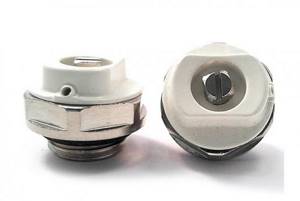
Its other names are: radiator needle air valve, air bleed valve, the most common is the Mayevsky valve. In textbooks, the name radiator needle air valve is usually used.
Purpose and scope of application
A common cause of inefficient operation of heating and cold radiators is airing. There is always air in the heating system water; it gets there in the following ways:
- dissolved air is always present in the water; it enters the system with recharge;
- enters when air is captured by the pump;
- in case of leaks;
- When corrosion occurs, hydrogen enters the water (in steel systems and in systems with aluminum radiators as well).
The Mayevsky tap is a device for bleeding air from heating systems. They are usually mounted on radiators (screwed into special holes in plugs) or at the highest points of the system.
Design and operation of the Mayevsky crane
The classic Mayevsky tap is made of brass alloys that are resistant to corrosion. It is a housing containing a cone needle valve inside. This Mayevsky valve is controlled by a shut-off screw, adjustable from the outside. When in the closed position, the valve is able to reliably hold the coolant inside the radiator. When the screw is turned to the side, the passage hole of the faucet opens, releasing the air inside the heating device.
Outside the metal body there is often a white plastic casing, giving the faucet a more noble and modern look. The design of the product may differ in its individual modifications, but the principle of operation of the Mayevsky crane always remains unchanged. The devices differ in external thread diameters , making it possible to easily select the appropriate option for any radiator. There are taps with 1 inch, ¾ or ½ inch threads.
To control the adjusting screw, use a key for a Mayevsky tap or a regular screwdriver. A square wrench is convenient because it takes up little space, allowing you to control the adjusting screw even if the radiator is in a hard-to-reach place.
Mayevsky air valve with key
In some cases, the operation of the crane can be controlled without the use of tools at all. To do this, just turn the valve by hand, ensuring that the air begins to bleed.
Device
A shut-off valve consists of a body with a hole on the side for air to escape and a conical screw that screws into it.
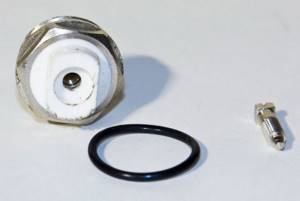
A fully tightened screw seals the hole in the faucet. The housing has a thread for screwing into a radiator cap or pipe with internal thread. A seal is placed on the housing to seal the connection. Typically, the material used for the faucet is brass. Steel products are practically never found.
Types and designs
There are practically only two types of Mayevsky crane: manual and automatic.
The automatic valve is not very suitable for central heating systems - it gets clogged easily. This device operates without human intervention - it contains a float that opens the valve when air appears.
The manual model has a very simple and functional design, it performs one single function, so all products have the same design.

1 – brass body; 2 – working screw with ducts; 3 – nylon cap; 4 – sealing ring.
The types of valves are shown in the photo:
Differences
There are fundamental differences only in the diameter of the external thread on the body: there are products with diameters of ½'' and ¾' (15 and 20 mm)'. There are products with a diameter of 1 inch.
The screw can be unscrewed using a screwdriver or a special wrench. The screw head has a square shape (occasionally a hexagonal or octagonal head) and a slot for a flat-head screwdriver. The key is supplied with the valve. There are models with a handle for unscrewing the screw.
The marking indicates the connecting diameter in millimeters; thread parameters are designated M10×1 - length 10 mm, metric thread pitch 1 mm.
How to bleed air from a heated towel rail

Typically, manufacturers provide the ability to bleed air from the heated towel rail through the Mayevsky tap. This manual valve is installed at the top of the ladder posts or at the front end of the shelf heater.
In the absence of an air vent, you can simply loosen the nut securing the PS to the riser. In this case, you should take into account the connection diagram of the device, whether the riser belongs to the hot water supply or heating system, the direction of coolant flow and the floor on which the heated towel rail is installed.
Removing the air lock
The need to bleed air from a heated towel rail arose immediately after the appearance of “ladder” models with several piping schemes. In Soviet times, U-shaped and M-shaped heaters were connected to the heating/DHW system directly, without a bypass; in principle, such problems did not arise.
In the “ladder” modifications, an air lock is formed due to the complex configuration of the tubular structure. Therefore, manufacturers equip their products with one or two manual air vents designed by Mayevsky, hidden inside decorative caps.
With Mayevsky crane
Without the involvement of specialists, a heated towel rail with a Mayevsky tap allows you to ventilate the heating device as needed.
The equipment belongs to the category of air vents, and has a primitive but effective design:
- on one side of the brass body there is a 1/2 or 3/8 inch cylindrical pipe thread;
- Inside there is a through channel for a threaded adjustment screw with a needle-shaped tip;
- the exhaust channel is drilled from the side into the polymer rotary insert.
The screw is unscrewed with a flat screwdriver, air under pressure exits the system into the air channel, the spatial position of which (up/down or sideways) can be adjusted with a rotary insert. As soon as water without air begins to flow into the side channel and the characteristic hissing disappears, the screw is screwed into the working position. The needle closes the hole and the descent stops. More details in the video below:
The main advantage of the needle valve designed by Mayevsky is its small size combined with a cylindrical shape. The device is easily hidden inside decorative glasses screwed onto ladder-shaped heated towel rail racks.
Manufacturers complete the product with a special key or round handle to save the user from even searching for a screwdriver.
In a private cottage with an open heating circuit, there is no need to expel the air; it goes into the expander tank itself. For closed systems, automatic air vents are used.
They are mounted at the top point of the system, and not the heating device, preventing the entire circuit as a whole from being aired.
Typically, float-type diverters are used, as in a flush cistern. Only they work the other way around - in working condition, the float is raised inside the chamber, the hole is blocked, when excess air enters the chamber, the liquid level in it decreases, the float “dives”, opening the drain channel.
Without air vent
If a complex-shaped heated towel rail was initially installed without a Mayevsky tap, removing the air lock from it will be a little more difficult. The general principle of operation is the same - destruction of the tightness of the system to squeeze air into the atmosphere with water pressure. The sequence of actions is as follows:
- the threaded connection is located at the highest point of the system, the riser does not need to be disconnected; Where to bleed air without a Mayevsky tap.
- loosening the coupling, nut, locknut;
- collecting water in a bucket using a rag thrown over the threaded connection, the lower edge of which is lowered into the container;
- tighten the thread after the air hissing stops.
If you remove the plug without a rag, the water-air mixture is sprayed throughout the bathroom uncontrollably, which increases the complexity of subsequent cleaning and can lead to damage to furniture and interior parts.
Advantages and disadvantages
- simple design;
- durability;
- compactness and the ability to install even in hard-to-reach places;
- reliability;
- low price;
- stylish design.
- the need to release air manually - Mayevsky’s taps do not operate automatically. They are not very suitable for filling large systems - it will take a very long time to bleed the air; in places where air constantly accumulates, it is better to install an automatic air vent;
- are not intended for use in systems with pressures exceeding 1.6 MPa.
What should you pay attention to when choosing a device?
Before installing the Mayevsky tap, pay attention to certain parameters of the radiators. For centralized heating schemes, it would be advisable to use manual devices that allow air to be vented as needed. It is better to install automatic taps if you have an autonomous heating system.
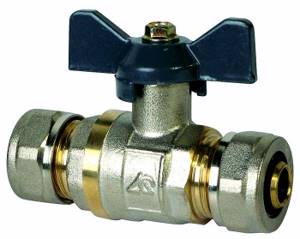
The manual device has a simplified design
In centralized systems, the coolant is highly contaminated, which will affect the constant clogging of passage holes in automatic structures. It is better to install automation in hard-to-reach places, but it is important to monitor the cleanliness of the coolant. If the mechanism is mounted on a battery that is located in a recess in the wall, then adjustment will become difficult due to the inaccessibility of the adjustment screw. In this case, you can use a special key, which is placed in the same plane as the battery.
Many heating systems are still created using cast iron radiators. In this case, you can use a manual model of the Mayevsky tap for cast iron radiators or automatic devices made of brass.

To adjust such equipment, a special key is used
Selection tips and prices
Buy valves at the store, not at the market. Preferably with a receipt. Although their design is simple and reliable, defective products still happen - they can be replaced. Do not buy steel products (if you happen to come across them); the ideal material is brass.
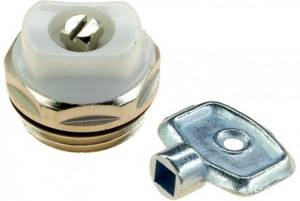
If there is a handle on the screw, bleeding the air will be much easier. And children at an interesting age too. Therefore, when choosing such a model, soberly assess the age and degree of playfulness of children's hands.
Don't go wrong with the case diameter.
Features of choice
When choosing a device model, you should consider some features of radiators:
- For centralized heating systems, the best solution is to use manual taps, which can be used to bleed air at any time. It is not advisable to use automatic taps in apartments or houses with centralized heating. The coolant in such systems is highly contaminated, as a result of which the tap hole will constantly become clogged with dirt;
- Automatically controlled faucets are good in private homes with autonomous systems, because the coolant is kept clean there. It is also recommended to install automation in places with difficult access; Automatic air vent on battery
- If the heating device is installed in some kind of recess or niche, then access to its end may be limited. In this case, it will be impossible to unscrew the screw with a regular screwdriver. Therefore, it is recommended to use an automatic Mayevsky tap for such a radiator. Or use a special key, which is located in the same plane as the battery;
- Many rooms still use old-style cast iron radiators. In this case, it is possible to install a manual Mayevsky valve for cast iron radiators, but it is better to use special automatic air vents made of brass, which have significant strength. Mayevsky's manual tap on a heating radiator made of cast iron
Rules for installation and operation of the device
The technology for installing the valve in heating radiators is not particularly difficult; even an inexperienced home craftsman can tackle it.
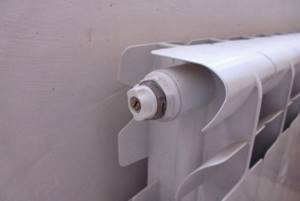
Required tools and materials
An adjustable wrench or wrench, FUM tape, valve, radiator plug with a hole for installing an air vent.
Connection diagram
The Mayevsky faucet is usually screwed into the upper radiator plug opposite the coolant supply.
Work progress
Before starting work, it is necessary to turn off the valves at the battery connection or close the riser in an apartment building. Then drain the water. In practice, work on the heating system of a high-rise building is carried out in the summer.
Then you need to unscrew the blind plug from the radiator with a wrench and screw in a new plug. On the plug you need to check whether the seal is on; you can wind several turns of FUM tape on the thread.

Then screw in the Mayevsky tap (and also check for the presence of a seal).
Fill the radiator or system with water and check for leaks. If connections are leaking, tighten the nut and tap with a wrench.
If you have cast iron radiators with steel plugs, you can drill a hole and tap the thread.
Where to call if the heating battery is leaking
If a person lives in an apartment building and the battery begins to leak during the heating season, the responsibility for eliminating the malfunction lies with the management company. Such a case is considered an emergency.
First of all, the resident needs to prevent the possible consequences of a leak. In order to prevent damage to the floor covering or, even worse, to avoid flooding the neighbors below, you need to find dishes to place under the leak. After this, immediately call the management company. The repair team must fix the leak in the heating battery as soon as possible and inspect the entire system in the apartment.
You can find out the phone number of the management company from your neighbors by studying the information on the walls of the entrance, in receipts, in the contract for the provision of services (for example, intercom service) or in online directories (for example, reformagkh.ru).
How to deflate
During operation, the device does not require any maintenance work.
Using the tap is very simple: before opening the valve and releasing air, you need to place a bucket under the tap and cover the tap with a rag (or polyethylene). Sprays of dirty or rusty water can fly along with the air and splash the wall, curtains or furniture. Then unscrew the screw with one hand (using a screwdriver, wrench or pen), and hold the rag with the other hand. The air will come out with a hiss when water starts to drip - tighten the screw tightly.
You can clearly see the progress of work on using the air valve in our video:
Frequent errors and problems during installation
It is necessary to unscrew the screw one to one and a half turns. This is quite enough. If you unscrew the screw too much, it will be difficult to screw it back in under pressure, and quite a bit of water will spill out.
It is advisable to mount the valve in such a position that the hole is directed away from the wall and downwards - the wall will not be splashed when water is released.
When replacing the air vent, when unscrewing it, you must hold the plug with a second adjustable wrench, otherwise it will be unscrewed from the battery.
Installation procedure
The easiest way to install a flanged ball valve is a very popular design. To install such a faucet, you must:
- Choose a suitable location.
- Wrap the threads of the tap with a sealant, for example, FUM tape.
- Screw on the tap.
- Check connections for leaks.
When figuring out how to properly install a tap on a battery, you should take into account a number of nuances that will help you perform these operations correctly. For example, if the faucet is embedded into an already finished system, you should cut out a small part of the pipe and cut a suitable thread, if one is missing. You can see more useful information on installation in the video:
Of course, before starting work you will need to remove the coolant from the heating system. Owners of private houses with individual heating will not have any problems, but apartment residents will have to coordinate this event with the management company.
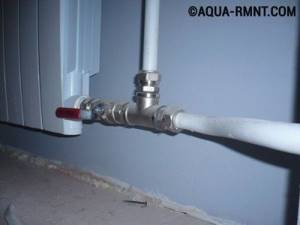
The ball valve is installed in the area between the battery and the bypass - a special jumper that ensures coolant circulation in the system, even when the valve is closed
The tap is installed in front of the battery and behind the jumper that connects the “input” and “output” of the coolant, so that when the flow is blocked, the coolant does not stop circulating through the system. If such a jumper (professionals call it a bypass) is missing, this problem must be solved when installing the tap on the radiator. When installing a faucet, you should consider two points:
- There must be no obstruction to the adjustment knob when set to any position.
- The user should have free access to the tap.
Before purchasing a faucet, of course, you should make sure that the diameter of the faucet and the pipe on which it will be installed match each other. It is also worth clarifying the type of thread. For a flanged valve, these elements can be configured as follows:
- both threads are internal;
- both threads are external;
- combination of internal and external threads on different sides.
Flange valves have a special marking in the form of an arrow, which indicates the direction of flow of the working medium, i.e. coolant. Do not neglect these instructions when installing the faucet.
To avoid leaks, FUM tape or other suitable sealant should be used correctly. In the case when the tap is installed on a pipe with an open thread (it is clear that the tap flange will have a closed thread), the seal is wound clockwise. In this case, the master is positioned facing the pipe opening. If the open thread is on the flange, the seal is also wound clockwise, but facing the tap, and not the pipe.
When the FUM tape is wound correctly and in sufficient quantity, noticeable efforts will be required to screw the thread. Upon completion of the work, part of the seal may protrude slightly at the joint; this is a completely normal situation, characteristic of good sealing. If the tap turns easily, too thin a layer of sealant was used. In this case, you should wind a little more FUM tape, and then screw the tap tightly to the pipe. Following these simple rules will help you install the faucet correctly and ensure a sufficiently high seal.
At the end of the work, it is necessary to check the connection by filling the system with water, preferably at high pressure. Neglecting this rule can lead to flooding of the room due to improper sealing of connections. Most often, residents of apartment buildings suffer from the consequences of unscrupulous work, since filling the heating system with water before the start of the heating season is usually carried out without warning on a weekday.
Expert advice
Water appears in the network quite often. Therefore, it is recommended to install air vents in each heating battery, register, U-shaped compensators with a loop turned upward, and at the highest point of the system.

It is necessary to unscrew the screw one to one and a half turns. This is quite enough. If you unscrew the screw too much, it will be difficult to screw it back in under pressure, and quite a bit of water will spill out.
If you want to install a valve in the cast iron plug of an old cast iron battery, it is better to replace the plug.
Drilling a hole and cutting threads in cast iron is extremely problematic due to its particularity - great fragility.
How to install a Mayevsky crane
The installation of the tap must be carried out in the upper part of the radiator device on the side opposite to the flow of coolant, since it is in this place that air collects. The specifics of each system should be taken into account. If a vertical heating system is installed in the house, then Mayevsky taps are installed on the radiators of the upper floor. In addition, air vents are installed on all heating devices that are connected to the riser below the upper connection axis.
When using a horizontal system, the taps are mounted on all heating devices without exception that can be connected to them.
If the Mayevsky tap is installed on a floor radiator located horizontally and parallel to the floor surface, then it is placed in the upper part of the highest point of the radiator. The adjusting screw points upward.
Many bathrooms have heated towel rails, which are heated by the coolant circulating inside them. On such devices a Mayevsky tap is installed for a heated towel rail. Installation has some peculiarities. If the heated towel rail has a bottom connection, then there is already a place for screwing in the tap. But for models with a side connection, it is necessary to modify it. A tee is cut into the supply pipe, into which the tap is screwed. The air outlet should be directed away from the wall. It is advisable to equip some models of heated towel rails with even two air vents.
Procedure for installing a tap on a radiator
1. Before installing the faucet, it is necessary to drain the water from the system.
2. Unscrew the plug located in the upper part of the radiator.
3. Screw the tap into place of the plug. The standard equipment of the faucet includes a rubber gasket that ensures the tightness of its installation. For a more reliable seal, it is recommended to screw FUM tape or oiled flax fibers onto the threads of the tap.
Tip: When installing the faucet, it is recommended to direct the air outlet hole slightly downwards. In this position, it will be more convenient to collect the water leaving the system, which will begin to follow the air.
If a tap is installed on an old cast iron battery that does not have a hole, then the following modification is performed. A hole is drilled in the cast iron plug, which has a slightly smaller diameter than the tap thread. The thread is cut inside the cast iron plug. After this, the air vent valve is fitted and screwed in.
In our separate article you will find photos of installing wall-mounted heated towel rails in the bathroom, as well as video instructions for installing it yourself.
You can read about making your own drainage well here.

